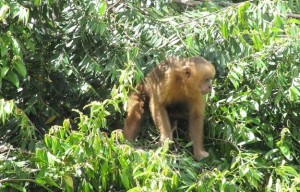They are our closest relatives. We share over 93% of our genetic makeup and likely a common ancestor, yet it’s often thought that humans are the only animals capable of reason and original thought. Sure some monkeys such as chimpanzees and the like can use sign language and operate computers but those are all skills they’ve been taught by human researchers right? They wouldn’t have been able to teach themselves right?
Whilst it has been known for quite some time that humans are not the only primates capable of using tools, it was only in 2004 that researchers from Cambridge University uncovered definitive evidence that wild monkeys make use of tools to aid in their food gathering efforts. The techniques observed by the capuchin monkeys were relatively basic however it was the first solid evidence of non-human primates using tools without any instruction.
More recent research reported in the latest Royal Society Biology Letters, has ratcheted up our level of understanding of just how ingenious our fellow primates can be. Scientists from the Universidade Federal de Pernambuco in Brazil have discovered a new technique used by the blond capuchin monkey (Cebus flavius) to fish for termites out of trees that has never been observed in any other species before nor even thought of by humans!
The technique involves the capuchin tapping the side of a termite branch, before breaking off a branch and using a rotating motion to insert the stick into the nest to retrieve the insects. The tapping appears to set the members of the insect colony ‘on-alert’ enhancing the response towards the ensuing breakage. As soon as the break does occur the “soliders” of the termite colony swarm the damaged point and are easily retrieved by the monkey.
After observing this technique the researchers tried it out for themselves and found that it was indeed an extremely effective method of retrieving insects. Two aspects in particular increase its efficiency. As mentioned earlier the monkey taps the outer surface of the nest before burrowing in. This appears to place the hive on ‘alert’ and improves their response time to the eventual penetration by the branchlet. Additionally, while the rotating motion they used to burrow their way into the nest did not appear to increase the speed at which the insects were caught or the overall catch, it did markedly reduce the likelihood of breaking the stick allowing the monkey to re-use it over and over again.
It is not yet known, exactly how the monkeys discovered the technique, but the observation of such a novel method for food gathering is nonetheless an exciting discovery and provides a further demonstration of just how similar we truly are to our primate cousins.
Viegas, Jennifer (2011, Mar 5th). Monkey Invent New Fishing Technique Retrieved from: http://news.discovery.com/animals/blonde-capuchin-monkeys-fishing-110309.html
BBC NEWS (2004, December 9th) Tool use confirmed in monkeys Retrieved from: http://news.bbc.co.uk/2/hi/science/nature/4083517.stm


One response to “Humans and Monkeys: Are we even more alike than we think?”